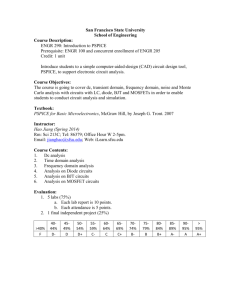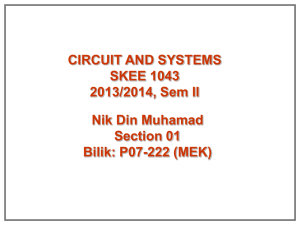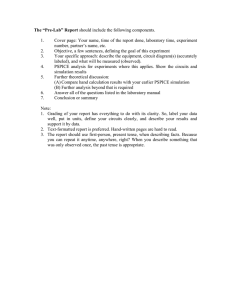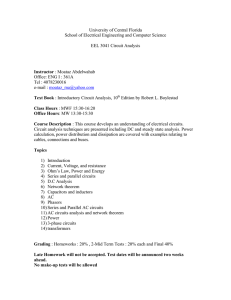elct 221 - electric circuits - University of South Carolina Department
advertisement
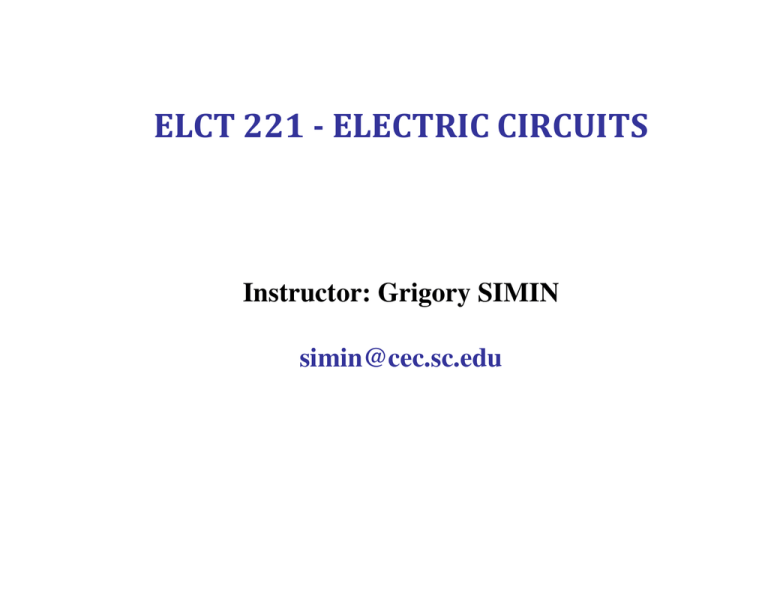
ELCT 221 - ELECTRIC CIRCUITS Instructor: Grigory SIMIN simin@cec.sc.edu Electric Circuits – what are they? Who need them? Do you need to know them? Electric circuit is an interconnection of electric elements. Electric circuit is also a model that describes, predicts and/or explains the behavior of any actual electrical system. Electric circuit is a KEY component of any field related to Electrical Engineering Electrical Components, Circuits and Circuits Diagrams Actual system: 100W Audio Amplifier Model (electric circuit): 100W Audio Amplifier An electric circuit is an interconnection of electrical elements. Electrical Engineering – what is it? Electrical engineering is the profession concerned with systems that produce, transmit, and measure electric signals. Over the past century and a half, electrical engineers have played a dominant role in the development of systems that have changed the way people live and work. Satellite communication links, telephones, digital computers, televisions, diagnostic and surgical medical equipment, assembly-line robots, and electrical power tools define a modern technological society. Electrical systems pervade our lives; they are found in homes, schools, workplaces, and transportation vehicles - everywhere. National Academy of Engineering: GRAND CHALLENGES FOR ENGINEERING • A diverse committee of experts from around the world • The most accomplished engineers and scientists of their generation • Proposed 14 GRAND challenges • Committee Chair, WILLIAM PERRY, Former Secretary of Defense, U.S. Department of Defense Professor of Engineering, Stanford University National Academy of Engineering: GRAND CHALLENGES FOR ENGINEERING Electrical systems and components Communication systems: televisions, cameras, transmitters, receivers, and VCRs; radio telescopes, used to explore the universe; network and satellite systems, radar systems, telephone systems... Communications: 100 years ago Telegraph operator printing telegram, 1908, courtesy Library of Congress On January 27, 2006, Western Union sent its final telegram. Communications: 100 years ago Communications today: Mobile Satellite Services Terrestar Satellite Phone has satellite, quad-band GSM, triband WCDMA/HSPA connectivity along with Bluetooth and WiFi. Convergence of Terrestrial and Satellite mobile communication systems Communication system: GPS The GPS system combined with computer electronics and software also forms a Signal Processing System Control systems: use electric signals to regulate processes. Examples: Temperature, pressure, flow rates regulators; fuel-air mixture control in a fuel-injected automobile engine. Motors, doors, elevators controls. Locks in the Panama Canal. The autopilot and autolanding systems. Control system example: dark activated switch Actual system Model (electric circuit) Signal-processing systems: transform the signals and the information contained in them into a suitable form. Computerized tomography takes signals generated by an Xray machine and transforms them into an image. Original X-ray signals are of little use to a physician; once they are processed into a recognizable image the information they contain can be used in the diagnosis of disease or injury. Modern electronic systems are highly sophisticated; they combine control, signal processing, communication, power and computer systems A sophisticated communications system enables the pilot and the air traffic controller to monitor the plane’s location. Onboard computer system manages engine functions, implements the navigation and flight control systems, and generates video information on screens in the cockpit. A complex control system uses cockpit commands to adjust the position and speed of the airplane. Power system provide and distribute the electric power needed for computers, to control the engines, keep the cabin lights on, A/C, show the movie etc. Signal-processing systems reduce the noise in air traffic communications and transform information about the plane’s location into the image on display. signal-processing systems power systems control systems computer systems communication systems The five major classifications of electrical systems: ELCT 221 textbook 1) Fundamentals of Electric Circuits, by Charles Alexander, Matthew Sadiku, 4th edition, ISBN 0077263197 / 9780077263195, McGraw Hill 2) PSpice for Basic Circuit Analysis with CD, by Joseph G. Tront, ISBN 0073263192 / 9780073263199, McGraw Hill. Supplemental readings (recommended, optional): Lessons In Electric Circuits A free series of textbooks by Tony R. Kuphaldt http://ibiblio.org/obp/electricCircuits/ Schaum's Outline of Basic Electricity“ by Milton Gussow, ISBN: 0070252408, McGraw-Hill "Getting to Know Semiconductors" by M.E Levinshtein and G. S. Simin, World Sci. Publ. Co., Singapore, London, NY, 1992; ISBN: 9810207603 MATLAB Programming for Engineers by Stephen Chapman (3rd edition) August 2004, ISBN: 0534424171 Publisher: Thomson ELCT 221 contents Part I – DC circuits Chapter 1: Basic concepts Systems of Units, Charge and Current, Voltage, Power and Energy, Circuit Elements Chapter 2: Basic Laws Ohm's Law, Nodes, Branches, and Loops, Kirchhoff's Laws, Series Resistors and Voltage Division, Parallel Resistors and Current Division Chapter 3: Methods of Analysis Nodal Analysis, Mesh Analysis, Nodal and Mesh Analyses by Inspection, Nodal Versus Mesh Analysis, Circuit Analysis with PSpice,Applications examples Chapter 4: Circuit Theorems Linearity, Superposition, Source Transformation, Thevenin's and Norton's Theorem ELCT 221 contents Part II – AC circuits Chapter 6: Capacitors and Inductors Capacitors, Series and Parallel Capacitors, Inductors, Series and Parallel Inductors Chapter 7: RC and RL Circuits Step Response of an RC and RL Circuits, Transient Analysis with PSpice Chapter 9: Sinusoids and Phasors Sinusoids, Phasors, Impedance and Admittance, Kirchhoff's Laws in the Frequency Domain Chapter 10: Sinusoidal Steady-State Analysis AC Nodal and Mesh Analysis, Superposition, Thevenin and Norton Equivalent Circuits, AC Analysis Using PSpice Chapter 11: AC Power Instantaneous and Average Power, Maximum Average Power Transfer, Effective or RMS Value, Power Factor Chapter 12: Three-Phase Circuits Balanced Three-Phase Voltages, Balanced Wye-Wye, Wye-Delta, Delta-Delta and DeltaWye Connections, Power in a Balanced System Computer tools and simulators In ELCT 221 (Room 1D15) MATLAB PSPICE Class WEB Page: http://www.ee.sc.edu/classes/Spring10/ELCT221/ http://www.ee.sc.edu/classes/Spring10/ELCT221/ The most important link for you Homework assignments will be given mostly using LON-CAPA http:// lon-capa.engr.sc.edu http://loncapa2.ee.sc.edu/adm/roles Login name: same as your EE account name Initial password: LC+xxxx where “+” is the “plus sign” and xxxx are the last 4 digits of your SSN. After the first logon you can change the password. A good practice would be to match your ENGINEERING password.

